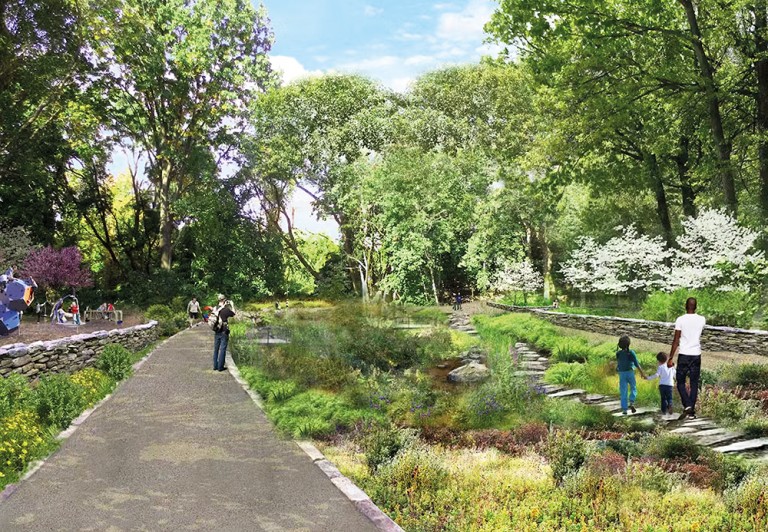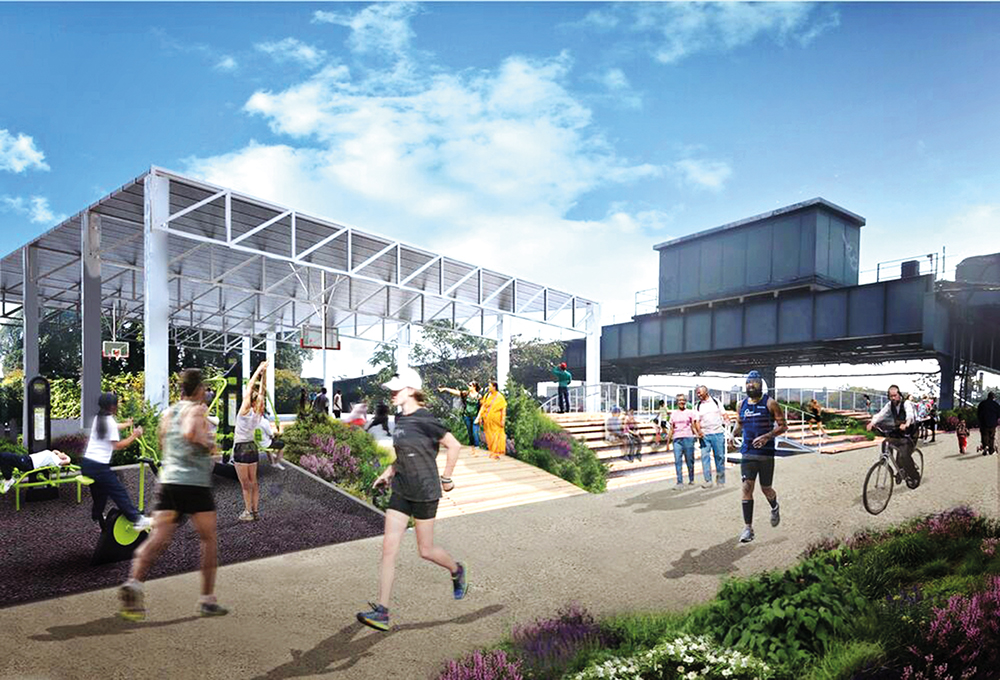By Michael V. Cusenza
The City this week pledged to allocate an additional $14 million to help complete Phase 1 of the QueensWay project.
In 2022, Mayor Eric Adams announced a $35 million investment for design and construction of Phase 1. This phase of the project would transform a vacant, city-owned corridor in Forest Hills into a five-acre park with 0.7 miles of greenway, providing residents with new open space, improved access to recreational amenities, outdoor education opportunities for students, and a safe transportation corridor connecting people to schools, businesses, and 10 bus lines.
The overall vision of the QueensWay is a re-imagining of the 3.5-mile stretch of the long-abandoned LIRR Rockaway Beach Branch—running from Rego Park to Ozone Park—as a thriving greenspace.
Tuesday’s QueensWay development was part of an announcement by Mayor Eric Adams trumpeting the release of the $93 billion Fiscal Year 2026 September Capital Commitment Plan — the largest September Capital Commitment Plan in city history — which includes new investments the Adams administration made over this budget cycle in affordable housing, public safety, education, cultural institutions, and more. The September Capital Commitment Plan also includes new capital investments, accelerates nearly $2 billion in funding to address the affordable housing crisis, and uses pre-existing resources to meet urgent infrastructure needs that support the health and safety of New Yorkers across the city, as well as boost economic development. Critically, not a single capital project was cut or had funding reduced under this plan. Investments made in and along with the September Capital Commitment Plan bring the city’s 10-Year Capital Plan to a record level of $182.8 billion.
New additions of $2.6 billion to the capital plan since the Fiscal Year 2026 budget adoption in June 2025 include:
Supporting the MTA’s capital plan ($800 million).
Funding $182.4 million in infrastructure and parks improvements related to the Atlantic Avenue Rezoning Plan as part of capital investments made to support the Adams administration’s New York City Strategy for Equity and Economic Development Fund, which will create jobs, housing, and economic opportunities, particularly in areas that have experienced disinvestment, including the following:
Comprehensive redesign of Atlantic Avenue in Brooklyn between Flatbush Avenue and Bedford Avenue ($120 million).
Park renovations in Crown Heights and Prospect Heights, Brooklyn:
John Hancock Playground ($25 million)
Potomac Playground ($14.1 million)
Dean Playground ($12.3 million)
James Forten Playground ($10.6 million)
Lefferts Place Community Garden ($500,000)
Continuing the Adams administration’s efforts to bridge the digital divide and invest in a more affordable city for working-class New Yorkers by distributing 350,000 new internet-enabled devices for free to K-12 New York City Public Schools students ($129.3 million).
Addressing East Side Coastal Resiliency project needs, including soil remediation, increased materials costs, and improved flood protection design and delivery ($91.6 million).
Replacing at least 145 Fire Department of the City of New York (FDNY) ambulances that are reaching the end of their useful life ($91 million).
Reconstructing the existing 34th Street Ferry landing to add additional slips for vessel docking in an effort to reduce crowding, improve service, and reduce delays at the current landing ($75 million).
Funding for infrastructure, parks, and school improvements with $71.8 million in investments connected to the Midtown South Rezoning Plan launched by the Adams administration to transform outdated industrial areas in Midtown South into a dynamic live-work neighborhood, including:
Broadway Vision Plan Expansion between West 33rd Street and West 38th Street and Herald Square and Greeley Square ($50 million).
Redesigning and upgrading McCaffrey Playground ($13.5 million).
Improvements to P.S. 11, P.S. 33, P.S. 340, the High School of Fashion Industries, and the Jacqueline Kennedy Onassis High School ($6.1 million).
New sports field lighting at St. Vartan Park ($2.2 million).
Funding to reconstruct the basketball court, pickleball court, playground, lawn, adult fitness equipment, and dog run at Printer’s Park in the Bronx ($16.7 million).
Funding renovations within the Jewish Children’s Museum ($16.3 million).
Funding to install radio communication systems to ensure systemwide communications for staff working at the Brooklyn Borough Based Jail facility ($14.3 million).
Renovating Ittner Place Park in the Bronx by turning a vacant lot into a basketball court and skate park ($8.7 million).
Adding funding to accelerate completion of the Bronx Animal Care Center, which will be substantially completed by January 2026 ($6 million).
Developing an application to streamline the Mayor’s Office of Criminal Justice’s ability to consolidate and review data from partner city agencies and service providers to enable more effective individualized decisions around social services or alternatives to incarceration that are available to justice-involved individuals ($4.1 million).
Funding a commemorative landscape to be added alongside a Holocaust Memorial at Queens Borough Hall ($2 million).
“This $93 billion plan makes the smart and forward-looking investments in the capital and infrastructure projects that will build our future. And, because we are the most pro-housing administration in city history and we are endlessly coming up with creative ways to address our generational housing crises, our September Capital Plan accelerates $1.8 billion in funding for affordable housing for both working-class New Yorkers and our city’s public housing residents,” Adams said. “That means major affordable housing construction and rehabilitation efforts will happen now — when they are most needed — because we do not have time to wait to deliver the real relief New York City needs to become the best place to raise a family.”
The September Capital Plan is the largest in city history and reflects $2.6 billion in new capital investments on top of the $2.2 billion made in the FY 2026 Adopted Budget, which included; $1 billion to support the Metropolitan Transportation Authority’s Capital Plan, $254.6 million to support New York City’s world-class cultural institutions, $239.5 million in additional investments for educational purposes, $207.6 million in improvements to city parks, $85.4 million for affordable housing needs, $52.4 million in upgrades for the city’s different library systems, $40.3 million in new investments at NYC Health + Hospital facilities, $39.5 million in improvements for The City University of New York facilities, and more.


